Seasons of Contrast: Andriy Shevchenko
No football season is the same. Whether you’re a player or a club, each season has its own unique defining feature which makes more the contrast between different seasons.
Improvising on that thought, I decided to start this series of articles where I analyze a player for two consecutive seasons – the caveat being that the player has to be at different clubs for the said seasons.
The first figure that came to my mind for this series – the contrast, or perception of, was pretty significant – is Andriy Shevchenko.
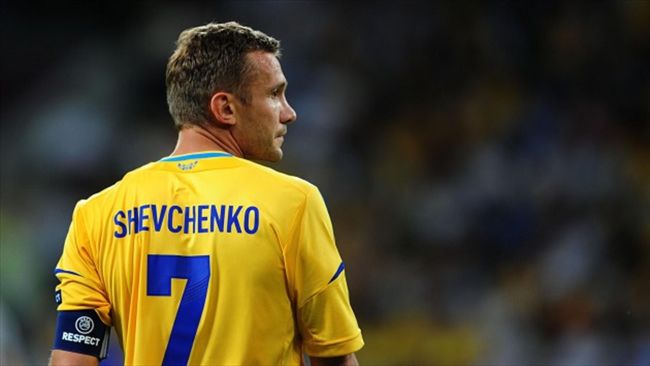
Shevchenko was one of the most prominent names in an era when world-class forwards were not a rare sight. I using “world-class” as a subjective term here as Lionel Messi, Cristiano Ronaldo and Robert Lewandowski have changed the definition of what a world-class forward is.
That being said, there’s no argument that Shevchenko was a world-class striker during his tenure at the San Siro. At Stamford Bridge, not so much (one of the primary reasons for me to explore his final season at AC Milan and first one at Chelsea).
Riding the wave from Kyiv to Milan
The Ukrainian hitman had starting making waves across the continent while plying his trade for Dynamo Kyiv.
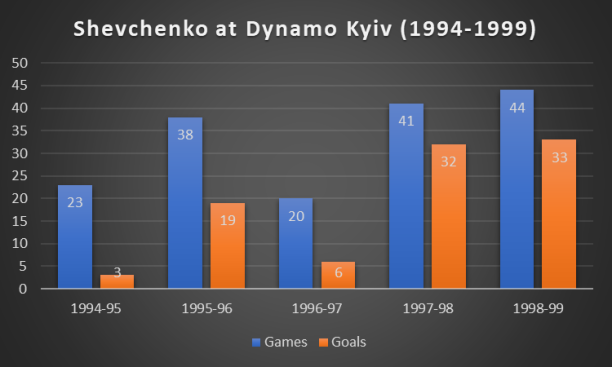
Debuting for the Bilo-Syni in 1994, Shevchenko enjoyed a fruitful five years at the Olimpiyskiy National Sports Complex. Scoring 93 times in 166 appearances for the Ukrainian club in five seasons, Sheva marked himself as one of Europe’s hottest attacking talents. A hat-trick in a 4-0 win over FC Barcelona in the 1997-98 UEFA Champions League was a signal that the Ukrainian striker could strut with the very best in the continent.
The following season, Shevchenko put FC Barcelona’s arch-rivals Real Madrid to sword, scoring all three goals in the Ukrainian club’s 3-1 aggregate win in the quarter-finals.
He followed that up with a brace in a 3-3 draw with Bayern Munich in the semi-finals but Bilo-Syni lost 0-1 at Munich in the second leg.
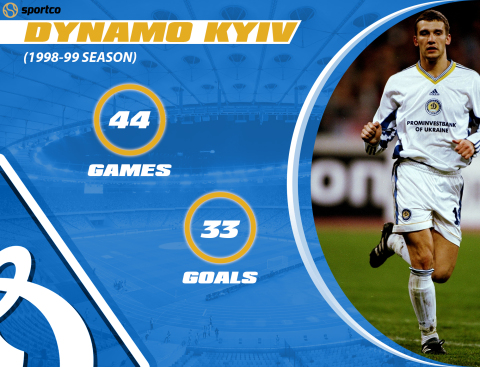
The 1998-99 season was Shevchenko’s second consecutive one where he found the net 30+ times. He also shared the Champions League scoring title with Dwight Yorke in the season. These achievements, coupled with his finishing ability convinced Silvio Berlusconi to splash the cash and bring him to San Siro.
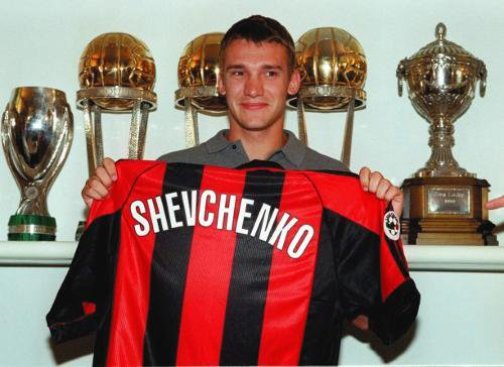
It’s raining goals in Lombardy
Sheva, signed for €23.91 million, hit the ground running in his first season at AC Milan. The forward plundered 24 goals in the league, winning the capocannoniere award (Serie A top scorer) in his debut season.
At a time when the spotlight was on Italian stars, considering their agonizing loss in the Euro 2000 final (France won via a David Trezeguet golden goal), Shevchenko himself became a headline grabbing act. Alessandro Nesta led Lazio prevented AC Milan’s bid to retain the scudetto but Sheva joined illustrious company, emulating Michel Platini, John Charles, Istvan Nyers, Gunnar Nordahl and Ferenc Hirzer by winning the capocannoniere in his debut season.
The Ukrainian would win the award again, in the 2003-04 season. In addition to the individual award, Shevchenko also brought home the league title, with his goals a key factor in helping AC Milan win their first scudetto since 1998-99. He would also go on to win the Ballon D’Or in 2004, becoming the third Ukrainian after Oleg Blokhin and Igor Belanov to win the title.
An injury-ridden Sheva played a peripheral role in the 2002-03 season when Carlo Ancelotti delivered AC Milan’s sixth European Cup/Champions League. Shevchenko did play a clutch role in the Champions League, scoring against Internazionale in the semi-finals and also slotting in the decisive penalty in the final against Juventus.
2005-06: Playing out the storm at the San Siro
The 2004-05 Champions League final in Istanbul is unforgettable – some god forsaken Liverpool fan is bound to come up with it in an online/offline discussion, conveniently forgetting that Liverpool were beaten by Milan in the 2006-07 Champions League final in Athens.
An AC Milan side featuring the dream defensive pairing of Paolo Maldini and Alessandro Nesta to relinquish a three-goal lead can be considered fictional. Truth, sometimes, is stranger than fiction.
Shevchenko was also one of the Rossoneri who lost his composure that night in Turkey. A man who put the ball past Gianluigi Buffon at Old Trafford to win the Champions League in 2003, ended up at the opposite end in 2005. Jerzy Dudek stopping Sheva’s feeble spot kick, celebrating and the latter with his heads down, reminiscent of Roberto Baggio in 1994 is an indelible memory.
After the exhilarating highs of the 2002-03 and 2003-04 seasons, the 2004-05 season was a steep fall for Shevchenko and AC Milan.
The 2005-06 season therefore, was to be one where Ancelotti and Shevchenko would come back roaring. A promising Alberto Gilardino. Marek Jankulovski and the ever-dangerous Christian Vieri headlined the transfer activity at Milan as the club primed itself for a tough battle for the scudetto.
Things, however, panned out differently.
AC Milan were locked in with Juventus in the league title race, with the bianconeri finishing up top with a three-point lead. Despite not losing to Juventus that season (win in Milan, draw in Turin), losses to Internazionale, AS Roma, Fiorentina and a surprise loss to Lecce in Matchweek 32 helped Juventus to keep the Rossoneri from the top spot.
The calciopoli scandal, however, changed all of that.
Juventus being the primary party in the scandal were stripped off the 2005-06 Serie A title and demoted to Serie B for the 2006-07 season. Milan would have been awarded the title but their involvement in the scandal also led to severe penalties.
The club was docked 30 points, making them fall to fourth. They were also barred from the 2006-07 Champions League, a decision that was overturned on appeal. The league title was ultimately handed to the Rossoneri’s city rivals, Internazionale.
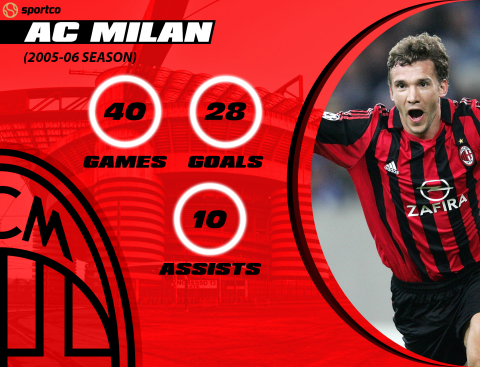
On field, Shevchenko had his shooting boots working, scoring 28 goals across all competitions. His league form, however, was slightly erratic, scoring 19 goals with five of them being from the spot. Do note that the figure is small relative to his earlier output for AC Milan in the league.
The Ukrainian was still clutch, with his goal in the Derby della Maddonina on 11 December 2005 making him the highest goalscorer in the derby’s history.
Despite a small reduction in his scoring output in the league, the Ukrainian weaved his way about the pitch to showcase his magical skills. Whether it was the superb finish against Lazio or his blistering strike to down Siena, the 2005-06 season was another in a seven-year peak for the “The Wind from the East”.
The Champions League saw the best of his abilities, as he finished as the competition’s top-scorer for the third time in his career. Milan were narrowly defeated by eventual winners FC Barcelona in the semi-finals, but Sheva’s wonder goals against Fiorentina and Fenerbahce still stand out.
The Ukrainian also achieved a great personal milestone in the season, passing Gianni Rivera to become AC Milan’s second-highest goalscorer in history.
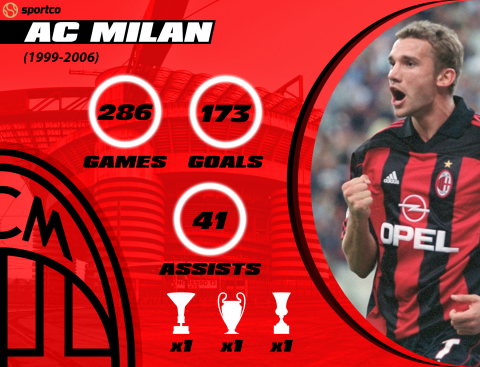
Shevchenko might have been setting the field on fire in 2005-06 but the fans’ attention was directed more towards his transfer links with Chelsea.
Things were further complicated with fans due to reports of Shevchenko’s wife, Kristen Pazik, angling for a move to England as she wanted their kids to grow up speaking English. Then Milan president Adriano Galliani infamously called it,
"A victory of the English language over the Italian language."
It’s common knowledge that football fans can be an unforgiving lot. Sheva might be regarded as an AC Milan icon today but in 2005-06, it was not surprising to hear Rossoneri fans call him a traitor.
Galliani and Milan also tried their best to keep their prized asset at San Siro. Shevchenko was offered a bumper six-year deal. Calciopoli had resulted in a wane for the Serie A and the Ukrainian, duly acknowledging the shift, packed his bags for London.
2006-07: Rainmaker no more
Fueled by Russian oligarch Roman Abramovich’s billions and Jose Mourinho’s tactical brilliance, Chelsea surged to the Premier League’s summit in 2004.
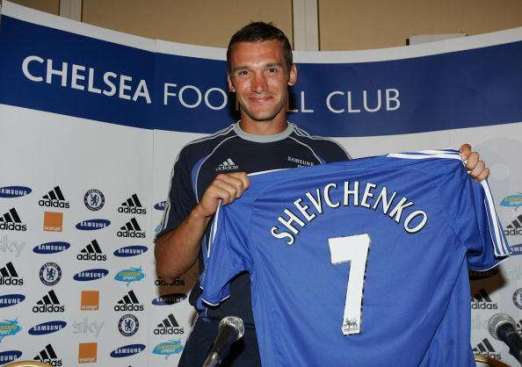
The Abramovich-Mourinho combo gave a massive push to a club that was known as a cup specialist. Two consecutive Premier League titles in 2004-05 and 2005-06 made west London an attractive spot for players looking to make their mark.
The club also broadened its ambitious gaze with the Champions League becoming a priority. In Abramovich’s eyes, there was no better way to put Europe’s elite on notice than by signing Shevchenko, a man who was on top of the Russian’s shopping list since 2003.
Abramovich had been courting the Ukrainian and had met him in 2004 as well, asking him about joining Chelsea.
“I happened to have an appointment there at the same time with another person, who introduced me to Roman,” Shevchenko told The Guardian,
“Straightaway he asked me whether I'd like to come to Chelsea, but I told him absolutely not, because I was happy at AC Milan. We'd just won the Champions League. I spoke to him for another five minutes and that was it.”
Sheva, in 2006, was the second-highest goalscorer in Champions League history and AC Milan’s second-highest goal-getter. Abramovich and Chelsea broke the then British record transfer fee by bringing in Shevchenko for £30 million – also the highest transfer fee for a 30-year-old player at the time.
Despite it being the Premier League, there were no questions around whether he would be able to adapt, as he was the Serie A’s top scorer in his debut season.
The Ukrainian legend started of his Blues career on an auspicious note, slotting in on his debut in a 1-2 loss to Liverpool in the 2006 Community Shield. Controlling a lofted long pass with his chest and then slotting it past Pepe Reina, Shevchenko immediately kissed the Chelsea badge. He gave Abramovich plenty to smile about that night, despite the loss. The same cannot be said about his former Milan coach as Ancelotti famously remarked,
“It looks like he has fallen for his new team in a hurry”
Later that month, the Ukrainian would open his Premier League account in a 1-2 loss to Middlesbrough. Shevchenko, however, was not his deadly self that season as his goalscoring became infrequent. Some of the goals were important, including his stunner against Tottenham in the FA Cup semifinals but he was unable to replicate the impact he had at San Siro.
Shevchenko was bought in by Abramovich to become Chelsea’s terminator up front. Chelsea did find their finisher except it was not Sheva.
Didier Drogba, who had scored a combined 32 goals in his first two seasons for Chelsea, became a machine up front in the 2006-07 season. The Ivory Coast forward scored 33 goals in all competitions, becoming the first Chelsea player since Kerry Dixon in 1984-85 to reach the 30-goal mark.
Drogba’s tally of 20 in the league good enough to win the Premier League Golden Boot. He scored six in the Champions League, three in the FA Cup and four in the League Cup.
Where Shevchenko struggled to score, Drogba found the net with reckless abandon, completing two hat-tricks in the season – against Watford in the PL and Levski Sofia in the Champions League. While Shevchenko’s quick feet did not help in outwitting opposing defenders, Drogba devoured them with his physicality.
With the Ivorian thriving up front, Mourinho tried to accommodate Shevchenko by shifting him to the wing but that did not help the Ukrainian’s fortunes
Shevchenko, forever the clutch player for Milan, ceded that moniker to Drogba as well. The Ivorian put two past Arsenal in the League Cup final and scored the extra-time winner against Manchester United in the FA Cup final at the Wembley.
Injuries and a hernia operation did cause Shevchenko to miss some game time as he made 51 appearances across all competitions. He scored 14 goals and provided 10 assists, which for a debut season in England, is not bad.
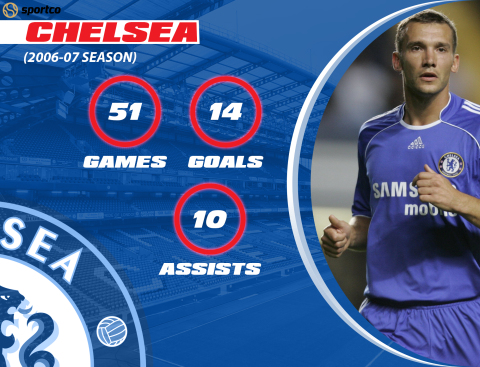
Was a return of 14 goals and 11 assists a good one for a £30 million signing? In the mid-2000s, not at all.
Shevchenko’s goal contributions were paltry for a player of his gargantuan reputation. A Serie A, Champions League and Ballon D’Or winner was expected to light up the Premier League. Shevchenko flickered instead and Drogba stepped up as the bright spot for Chelsea, who failed to defend their Premier League title and also saw Mourinho feud with Abramovich and subsequently be sacked the next season.
Being Abramovich’s favored signing didn’t help Sheva when Mourinho had a now trademark tiff with the club owner and management. Shevchenko was infamously not the on the list of Mourinho’s eight ‘untouchables’ in the squad.
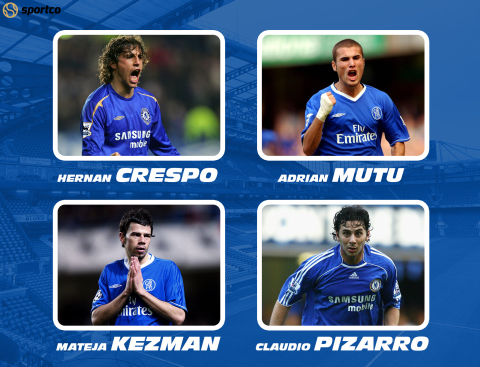
That being said, the latter’s tactics did not give any sign that the Ukrainian would rediscover his Milan days at Stamford Bridge. In retrospect, Shevchenko was another name in a list of high-scoring forwards who faltered in west London. Mateja Kezman, Adrian Mutu, Claudio Pizarro and Hernan Crespo, all were unable to live up to the hype at the Bridge. The Argentine himself had racked up a decent goal haul while with the Blues.
Drogba’s rise to the top and Shevchenko’s own reserved nature were contributors to the latter’s underwhelming season as told by John Obi Mikel to The Athletic,
“Didier always loved the challenge, the bigger the game or the harder the competition for a place became, he liked to prove himself. That’s what happened when Sheva arrived, he tried to take his performance to another level to make sure he was the main man.”
Sheva had a good start in the 2007-08 season too but was not able to capitalize on it. He became a benchwarmer under Avram Grant and was not garnering the interest of the elite clubs anymore.
The aftermath
A loan spell at AC Milan in 2008 looked to be a much-needed change for Shevchenko but he was not the same anymore.
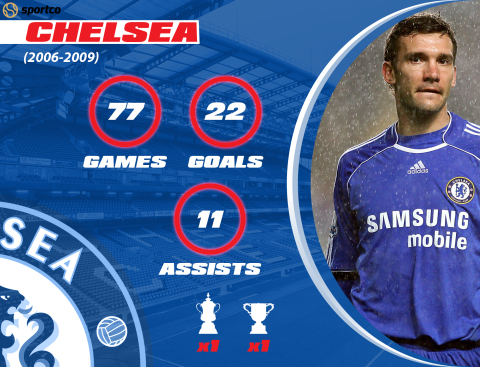
Older, slower and less confident after his underwhelming spell at Chelsea, Sheva was not the same player any more. He did have a mini-renaissance on his return to Dynamo Kyiv, scoring 30 goals in three seasons. His time at the very top, however, was definitely over.
Shevchenko joined Chelsea when he turned 30. He definitely had another two-three years in the tank but the decline was accelerated by his indifferent form and limited chances at Stamford Bridge.
In a Premier League centric football fandom, Shevchenko’s failure at Chelsea does affect his legacy. Yet it should not be forgotten that the Ukrainian was one of the world’s best at Milan, at a time when the Serie A was the playground for the top players. A forgettable spell in England should not be the punchline for “The Wind from the East” that conquered Italy and Europe.


.png)
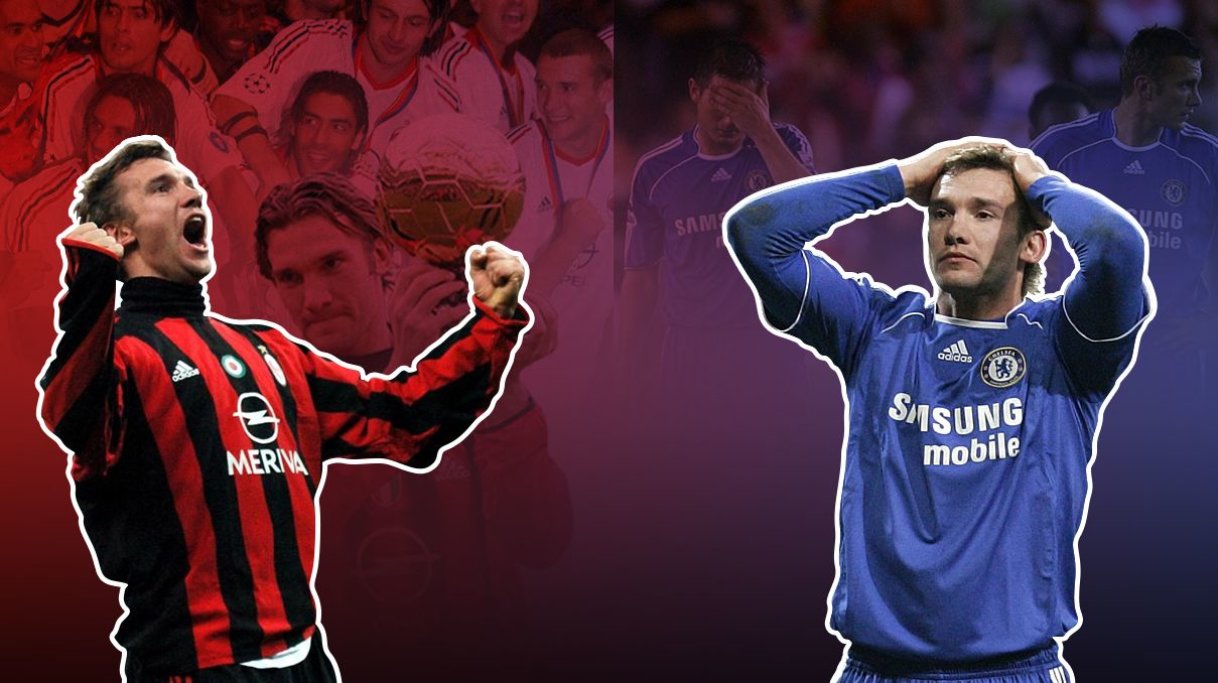

Leave a Reply